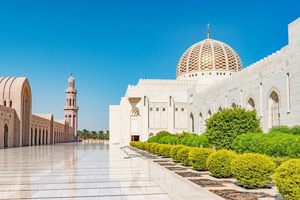 Al Alam Palace
Al Alam Palace is one of the most popular picture spots of Muscat. Originally built over 200 years ago by Sultan Qaboos’s 7
th grandfather, Imam Sultan bin Ahmed, it was rebuilt as a royal residence in 1972. This is one of the 6 royal palaces and the one, where the Sultan prefers to hold ceremonies and accept highly distinguished guests, such as the Queen of England and the Queen of the Netherlands. Unfortunately, as this is a working residence, visitors are not allowed to enter the complex, but they can take pictures of the intriguing blue and gold decorated entrance. The palace is flanked by two Portuguese forts from the 16
th century –
Mirani and
Jelali.
Bait al Zubair is not to be missed – a museum, as well as a heritage and a cultural centre. It opened in  1998 as a privately-owned museum, entirely funded by its founders – the Zubair family. The museum displays a collection of Omani artefacts, such as ancient weapons, household items, costumes, handcrafts, stamps and coins. The building itself is an architectural masterpiece as well, proud recipient of an Award for Architectural Excellence. The complex consists of 6 buildings, situated within a garden of indigenous plants and trees and a miniature traditional Omani village.
1998 as a privately-owned museum, entirely funded by its founders – the Zubair family. The museum displays a collection of Omani artefacts, such as ancient weapons, household items, costumes, handcrafts, stamps and coins. The building itself is an architectural masterpiece as well, proud recipient of an Award for Architectural Excellence. The complex consists of 6 buildings, situated within a garden of indigenous plants and trees and a miniature traditional Omani village.
Sultan Qaboos Grand Mosque is one of the proudest possessions of Omani people. It held several world records – the largest mosque, the largest chandelier and the hand-knotted carpet in the world – it took 600 women 4 years to complete. Although those records have now been broken, the mosque remains an incredible piece of modern Islamic architecture. It can take up to 20 000 worshippers and is lavishly decorated. The Mosque is open to non-Muslims visitors every day from 8 am to 11 am every day, except for Friday. The entrance is free, just make sure you are dressed modestly and have legs and shoulders covered (and hair if you are a woman).
 There are more wonderful places and sites in Muscat to visit and get to know the unique Omani culture, history, people, food, nature and everyday life. Go shopping for traditional pottery, silver jewellery, dates, frankincense and traditional Omani clothing at Muttrah souk. Breath in the nature at Wadi Shaab (the Valley of Youth) – a spectacular formerly dry river bed, now with emerald green pools and refreshing waterfalls amongst white-washed cliffs and terraced plantations. Go for an evening walk at The Corniche – the city’s old commercial centre, now beautifully preserved and buzzing with life after sunset.
There are more wonderful places and sites in Muscat to visit and get to know the unique Omani culture, history, people, food, nature and everyday life. Go shopping for traditional pottery, silver jewellery, dates, frankincense and traditional Omani clothing at Muttrah souk. Breath in the nature at Wadi Shaab (the Valley of Youth) – a spectacular formerly dry river bed, now with emerald green pools and refreshing waterfalls amongst white-washed cliffs and terraced plantations. Go for an evening walk at The Corniche – the city’s old commercial centre, now beautifully preserved and buzzing with life after sunset.